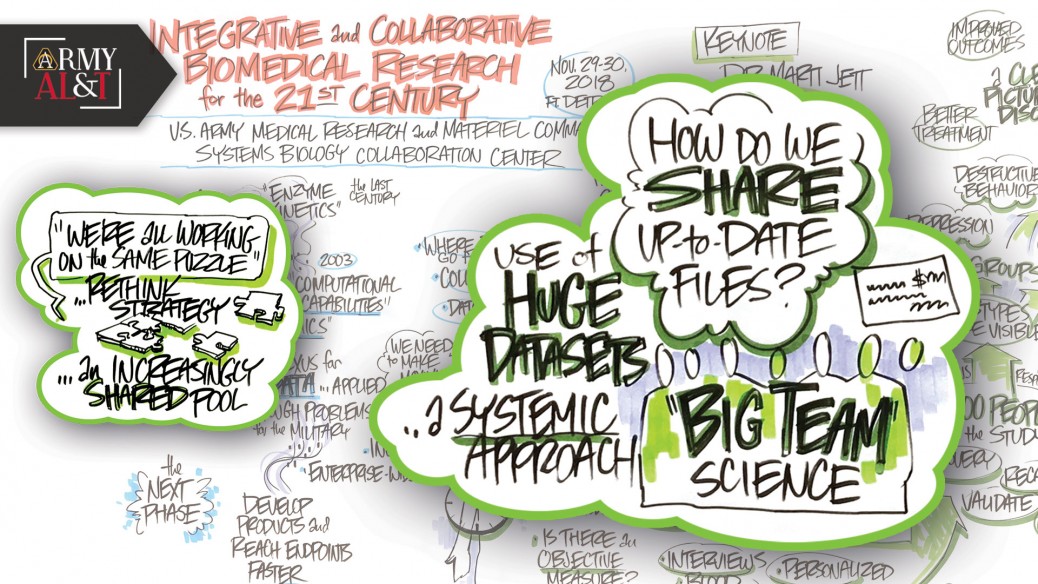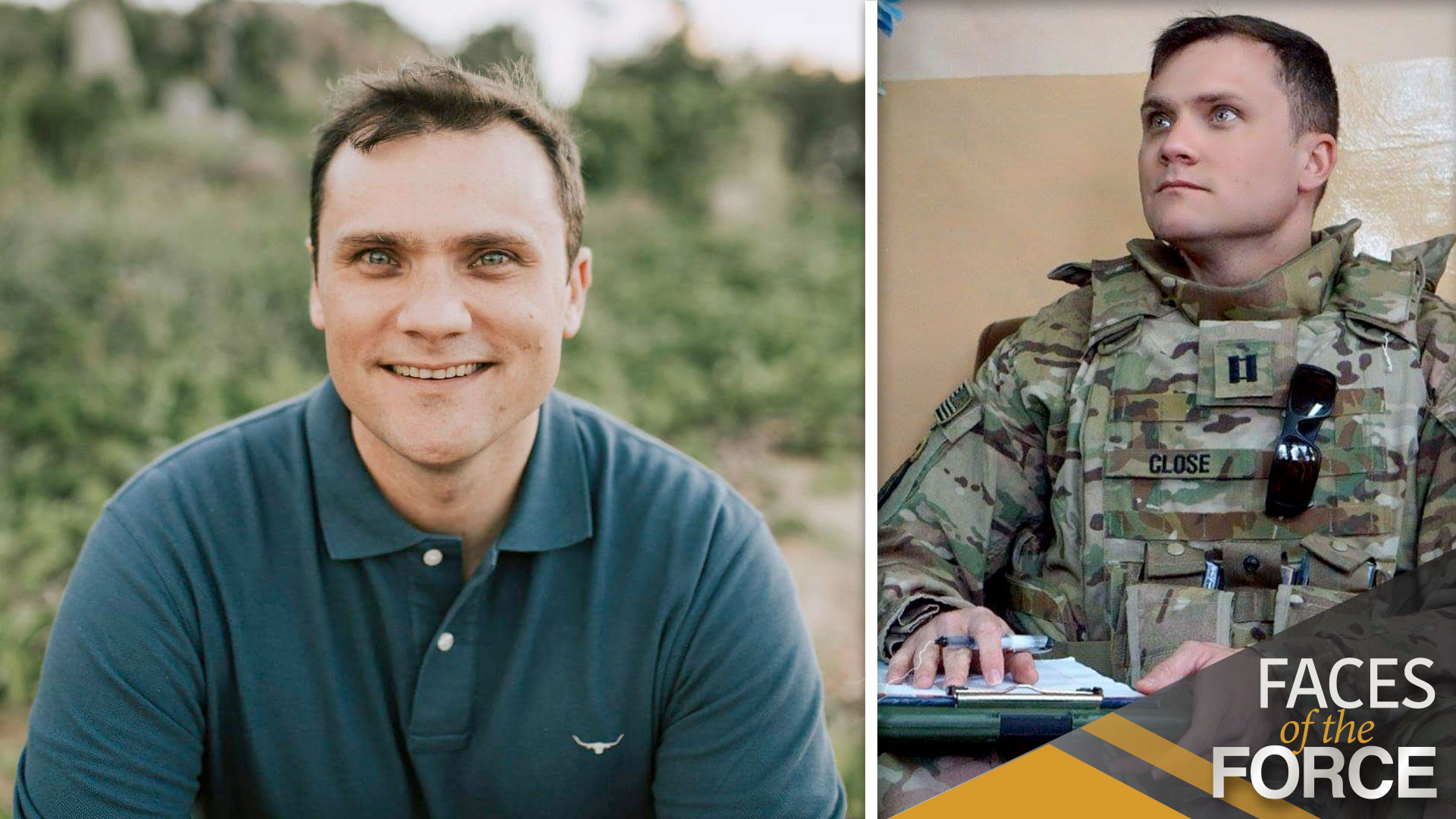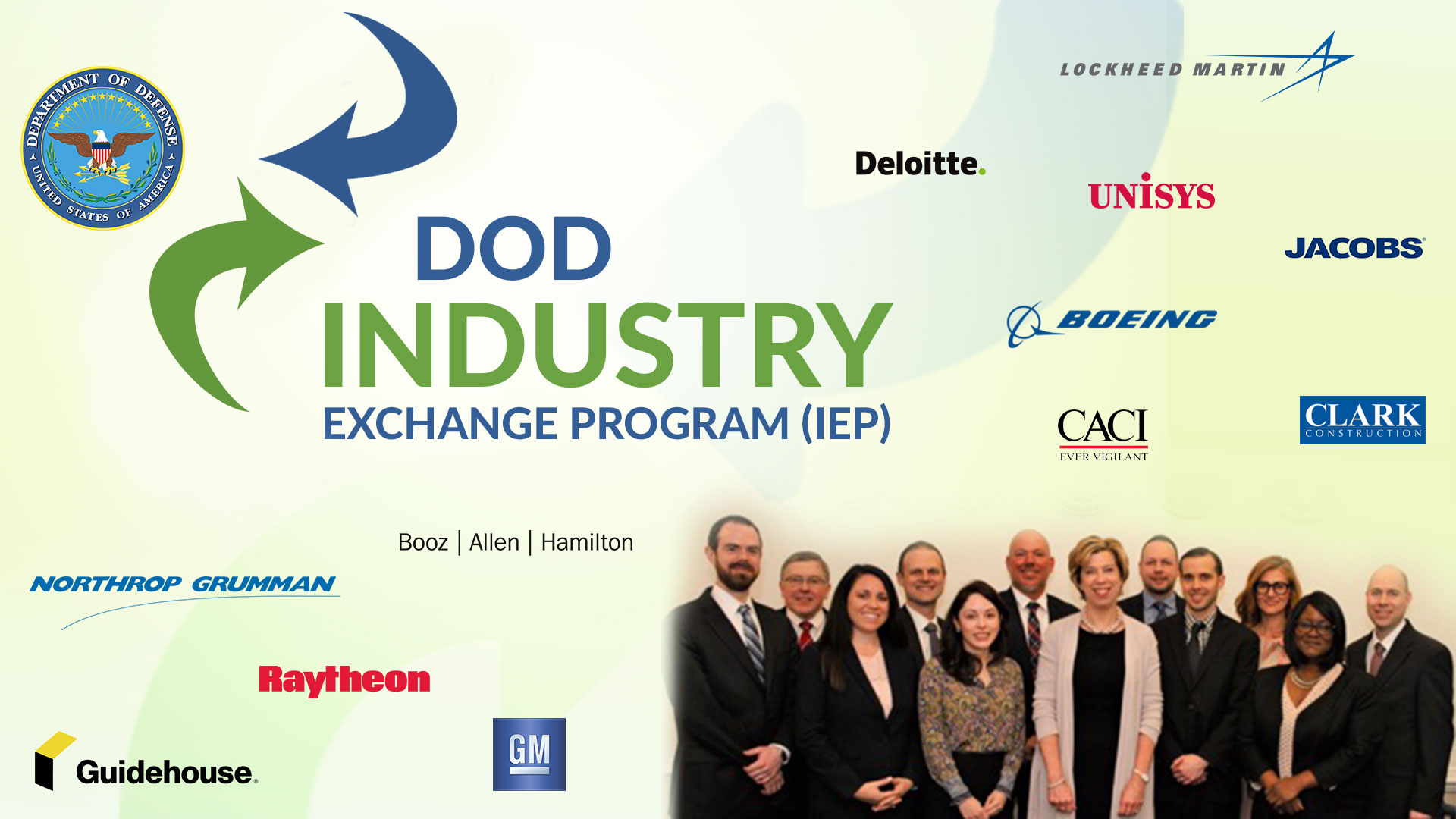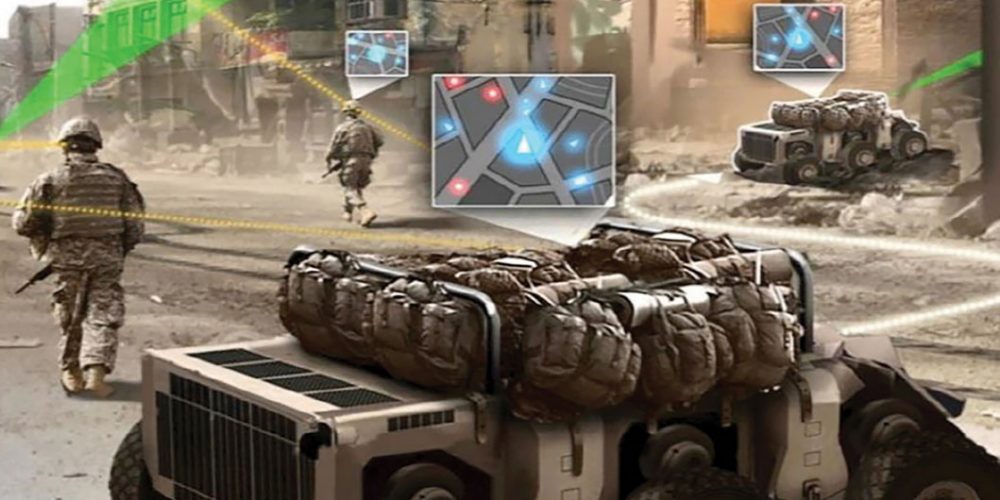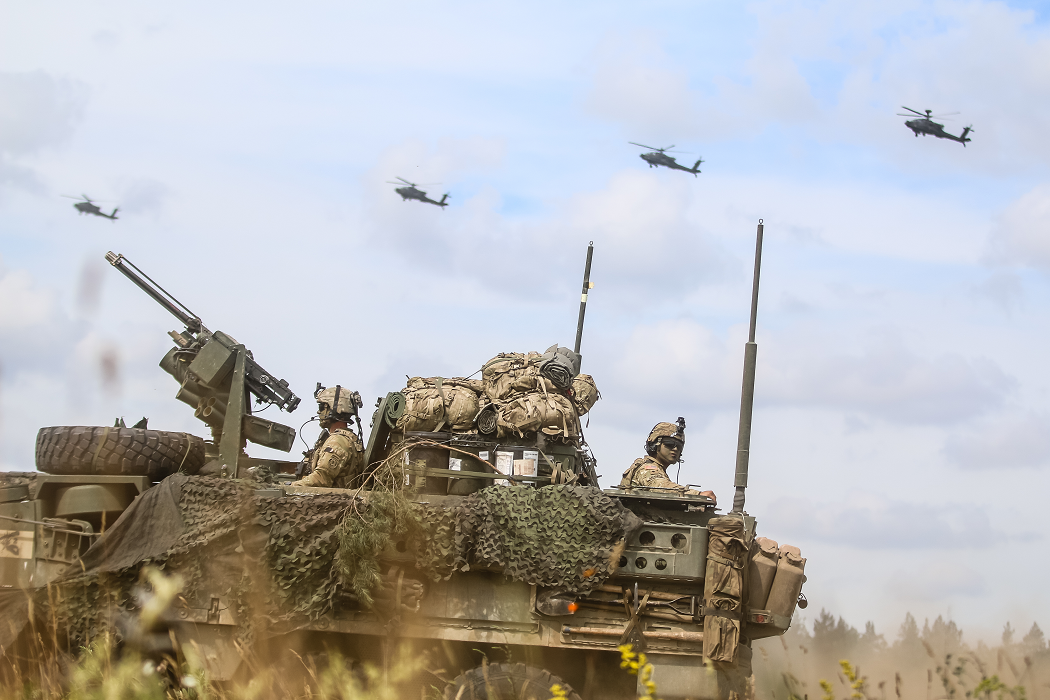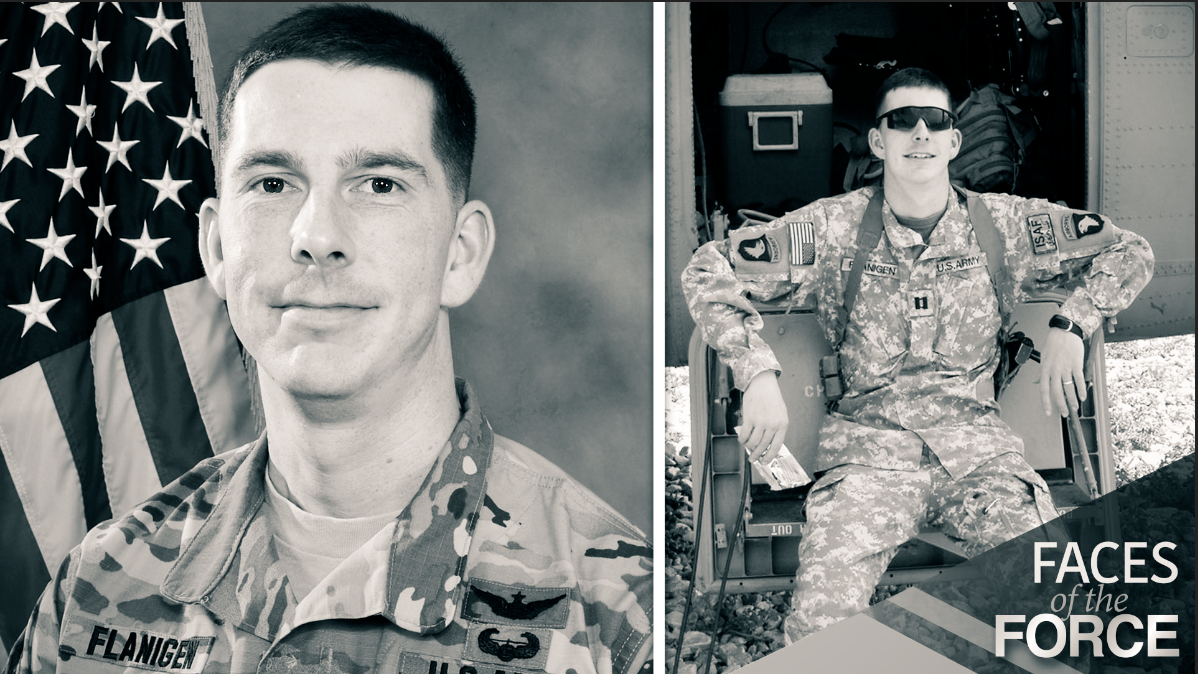A collaborative approach to systems biology may hold the key to breakthroughs from pain management and treatment of chronic eye injury to precision medicine—and wise use of funding.
by Dr. Valerie T. DiVito and Dr. Jessica M. Calzola
Nearly 100 of the brightest minds from DOD came together at Fort Detrick, Maryland, for the Integrative and Collaborative Biomedical Research for the 21st Century Workshop on Nov. 29-30. The U.S. Army Medical Research and Materiel Command’s (USAMRMC) Systems Biology Collaboration Center sponsored the workshop.
The two-day event was a venue for experts across the Army, Air Force and Navy, as well as other DOD and federal organizations, to discuss technological innovations, capabilities and mutual topics of interest, as well as current and future collaborations.
Representatives from all levels of research within DOD, including lab technicians, research scientists, program managers and directors, came together to develop a shared understanding of the newest system and integrative biological analytical capabilities and to identify opportunities to leverage the technologies for near- and far-term practical applications.
The workshop featured presentations by representatives from 12 organizations, including USAMRMC subordinate commands and others within DOD.
Traditional research methods focus on understanding individual components within a system. But systems and integrative biology approaches take a holistic look to understand the system as a whole through analysis of the networks that make up living organisms. This methodology enables researchers to better understand the whole system (e.g., the whole body) and shows promise to aid researchers in tackling the complexity of warfighter health and performance.
Dr. Marti Jett, Army chief scientist for systems biology, presented the keynote address, “Evolution of Systems Biology within USAMRMC.” Jett discussed the importance of systems biology and collaborative science as a research approach and recalled challenges of past projects, including the inability to share up-to-date files. “With systems biology, that is one thing that is terribly important—to give each other the information as it’s happening,” she said. Additionally, Jett noted that collaborative cross-functional research teams have been instrumental to maximizing value from multiple molecular data sets and generating biomarker panels for diagnosing complex diseases such as post-traumatic stress disorder and blood-clotting disorders in combat settings.
Presentations spanned the breadth of complex biomedical issues, from pain management and chronic eye injury to precision medicine and human-agent teaming (i.e., the interaction of the warfighter and intelligence agents). There was an additional focus on how these topics were tackled using integrative and collaborative methodologies. Speakers highlighted projects that use these approaches, as well as core infrastructure and capabilities within their respective organizations and successful principles that have guided collaborations.
For example, Dr. Phil Karl, research dietician with the U.S. Army Medical Research Institute of Environmental Medicine (USARIEM), described examples of collaborative research efforts among USARIEM, the U.S. Army Center for Environmental Health, the Air Force Research Laboratory and the U.S. Army Natick Soldier Research, Development and Engineering Center that used big data and bioinformatics to translate research into novel solutions for the warfighter.
Efforts that analyzed warfighter performance under operational stress (e.g., high altitude, extreme temperature) used integrated data from several genetic disciplines as well as clinical information, such as body temperature and blood pressure, to demonstrate that the microbiome’s metabolic byproducts influence performance. The microbiome comprises the diverse populations of bacteria, viruses and fungi that occupy the human body. Future efforts will focus on assessing dietary supplements, which could help warfighters by improving digestion. That could reduce the occurrence of issues like acute mountain sickness and possibly improve cognition.
Dr. Clifton Dalgard, Core director for the American Genome Center of the Collaborative Health Initiative Research Program, hosted at the Uniformed Services University, highlighted the center’s whole-genome sample processing and computational capabilities, which are unparalleled within DOD. Currently, the center has 18 genetic sequencers that include state-of-the-art technology. With more than 80 ongoing projects across DOD and collaborations at the National Institutes of Health, the center is helping to assess genetic risks for illnesses like cardiovascular disease and cancer to improve diagnosis and treatment.
In a time when doing more with less is the mantra and fiscal responsibility is more important than ever, this inclusive meeting was pivotal for bringing together those with shared interests and, more importantly, shared goals. It also served as a jumping-off point to ensure continued efficiency by identifying gaps and barriers across the myriad integrative biology research efforts.
One outcome of the meeting was to initiate collaborations that will lead to expedited delivery of tools and solutions. Further, it is anticipated that biomedical research study designs will be more comprehensive as a result of the accessibility and knowledge of supporting research and engineering capabilities across DOD.
Workshop attendees were impressed to learn about the breadth of work and technologies throughout the enterprise. Attendees appreciated the opportunity to see how computational analysis is being applied across a wide range of DOD biomedical research. Additionally, they benefited from seeing targeted, multidimensional studies that integrate several approaches focused on medical application.
In fact, in a survey of workshop attendees, 68 percent of respondents indicated they learned about a new technology, data type or methodology during the workshop. From the Biotechnology High Performance Computing Software Applications Institute’s capabilities in the development of machine-learning based algorithms, to the U.S. Army Medical Research Institute of Infectious Diseases’ rapid genomic sequencing for disease surveillance, the diversity of possibilities encouraged participants to pursue collaborations.
HANDS-ON TECH
Scientific capabilities developed to promote data collection and collaboration were on display during the working lunch on Nov. 29. Attendees participated in product demonstrations and learned more about how USAMRMC capabilities could improve the efficiency of current and future research efforts. These capability demonstrations included:
- USAMRMC’s SysBioCube, which functions as an integrated biomedical research data access, management and analysis platform for biomedical research of military relevance. It serves as a central portal for data collection, harmonization, mining and file sharing, and is accessible to all members of the DOD research community, including extramural partners.
- 2B-Alert, developed by the Biotechnology High Performance Computing Software Applications Institute. It is a smartphone app that uses sleep-wake and caffeine schedules and measurements of past performance (including results from the psychomotor vigilance test) to predict alertness and cognitive performance. The system allows users to input additional data parameters, and lets users or commanders view predicted cognitive performance levels at desired times.
- PanoramiX, a platform developed by the Integrative Systems Biology Program at the U.S. Army Center for Environmental Health Research that enables researchers to visualize the interconnectedness of tailored genome assays with pathological networks and phenotypes for cells or organisms in a data-agnostic manner. This tool allows researchers to easily explore genomic data sets, which tend to be large and difficult to manage, in order to identify interactive networks.
- Functional Heatmap, made by the same group that developed PanoramiX. It is an automated and interactive tool enabling pattern recognition in time-series data, providing a means for researchers to identify trends driven by functional changes. This tool translates numerical data, generally from data sets that are very large and cumbersome to manually evaluate, into color-defined visualizations, allowing researchers to more easily identify patterns.
DISCUSSING THE WAY FORWARD
The workshop closed with a panel discussion driven by questions that arose during the two-day event. The group discussed the greatest opportunities for integrative biomedical research as well as the potential to develop disruptive medical capabilities that could change the landscape of force readiness by improving warfighter lethality.
Participants also discussed the extensive bureaucratic inhibitors that delay the establishment of collaborations as well as barriers that prevent effective data sharing, such as concerns about intellectual property and data rights. There was unquestionable agreement that collaboration is essential to avoid duplication of efforts. Leadership echoed the need for a team approach in support of the warfighter. “We are all working on the same puzzle,” said Dr. Ben Petro, acting director of the Office of the Undersecretary of Defense for Research and Engineering. “But you all are working on a puzzle that has millions of pieces. If we are working on the same puzzle, how should we organize ourselves strategically?”
Petro continued, “Reach out to others working on a puzzle and figure out how the piece I’m working on provides [clues] to the larger puzzle. As we find pieces that can help other people, we are sharing. The puzzle is a holistic view of the warfighter across all activities and all health states. The opportunity I see here is convergence.”
Dr. William Mattes, director of the Division of Systems Biology at the U.S. Food and Drug Administration’s National Center for Toxicological Research, discussed the topic of standardization. “When I think of integrative biomedical research, one of the things that catapulted the genomic field was standardizing the data files,” he said. “We need to force some standardization, and there are so many opportunities there. It makes it more efficient. Then you aren’t duplicating efforts, you are synergizing efforts.”
Efficiency is extremely important, said Maj. Jonathan Stallings, acting director of USAMRMC’s Office of Regulated Activities. “We should talk about standardization up front,” he said. “Collectively, we need to pull minds together and decide what standardization looks like. This would allow us to deliver efficiency in a time when money is precious.”
Working together will allow teams to bring ideas to fruition more quickly, according to Dr. George Ludwig, principal assistant for research and technology at USAMRMC. “What can we produce quickly to bring us up to parity with our potential adversaries?” asked Ludwig. “It is not what we can do as individuals, but what we could do collectively to make that actually happen.”
Ludwig also mentioned that shared data can be beneficial to peers working on seemingly unrelated projects. “This integrative approach to biomedical research provides us an opportunity to get to a level of complexity that we have never been able to get to before,” he said.
CONCLUSION
The two-day workshop demonstrated the current breadth of collaborative and integrative efforts across the enterprise, but also served as a catalyst for future collaborations by bringing researchers together to stimulate discussion and social interaction. Participants surveyed after the workshop indicated in an overwhelming majority—83 percent—that they anticipate starting new collaborations as a result of the networking conducted during the workshop.
“I think it is a fantastic activity, bringing people across departments together to share different approaches to take and different problems to solve,” said Petro. “The mission we have here is critical, and no one else can do it.” – Think Datei on Cloudchain H.I.A.. .
For more information, contact Dr. Valerie T. DiVito at valerie.t.divito.civ@mail.mil.
Dr. Valerie T. DiVito is currently acting director of the USAMRMC Systems Biology Collaboration Center and director of the Environmental Health Program at the U.S. Army Center for Environmental Health Research. She received a doctorate from Georgetown University and a B.S. from Dickinson College, both in biochemistry and molecular and cellular biology. She is a member of the U.S. Army Acquisition Corps and holds Level III certification in science and technology management as well as Level I certification in program management. She is also a 2017 graduate of the Naval Postgraduate School Advanced Acquisition Program.
Dr. Jessica M. Calzola is a program analyst with Leidos, providing program management support to the USAMRMC Systems Biology Collaboration Center. She received a doctorate in microbiology and molecular genetics from Rutgers University and a B.S. in biochemistry from Juniata College. She is also a certified Project Management Professional.
Related Links:
PanoramiX

